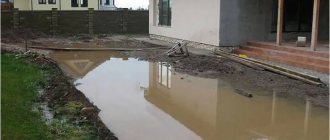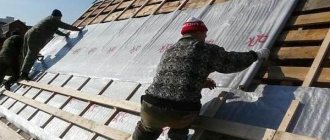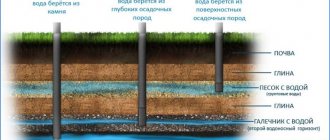To prevent the water in the well from freezing, it should be insulated. Almost all areas of country houses are equipped with a well, which ensures uninterrupted water supply. The cold winter months are risky as the casing and supply pipe may freeze. To ensure that the water supply does not stop, the home owner must know at what temperature the water freezes outside, as well as how to insulate the well and prevent freezing. You can do this yourself using available materials.
Ways to insulate an outdoor water source
When choosing materials for insulating a well, it is necessary to take into account the climatic conditions of the area in which the well is located. The choice of materials is directly influenced by the level at which groundwater is located. If the area has a mild climate, you can use sawdust, straw or high-moor peat to insulate the well.
Thermal insulation material can be purchased at any hardware store
To insulate a well column, it is necessary to surround the box into which the insulation is poured.
The thermal insulator must be protected from moisture, otherwise it will lose its thermal insulation properties. More severe climates require the selection of a material with high technical characteristics. The well can be insulated with polystyrene, basalt wool, foam insulation, glass wool, and polystyrene foam.
How to insulate a well:
- Cover the riser with a metal mesh with small cells.
- Equip the structure with a metal casing, not forgetting to leave free space to place the insulation.
- Fill with sawdust or the material that was chosen for insulation.
- The valve should be equipped with a tin tray, which should extend beyond the metal casing. It is important to maintain a slope that prevents moisture from entering.
For high-quality insulation, you can use an additional heating system. To do this, the well must be equipped with a small heater and a floating sensor that monitors freezing. The sensor will work as soon as an ice crust forms on the surface of the water.
Installation of an insulated box
In regions with a mild climate and minor frosts, it is not necessary to install a caisson. The well head along with all the equipment is placed in an insulated box, which is opened if necessary. The protective structure can be built from wooden building materials or made of brick. The inside walls are covered with heat-insulating material. In addition to insulation, such a structure can also perform a decorative function if original design ideas are introduced into its design.
Insulation of a well in regions with a warm climate is carried out by building a small house in which equipment and pipework are hidden
Measures to prevent freezing
Usually the well is located at a distance of several meters from the house. It can also be located in the basement, but even then care must be taken to ensure that the water in it does not freeze. Most often, water freezing occurs in the area called “ground-air”. Crystallization of water affects the air section of the pipe.
Experts call measures that help avoid water freezing passive and active.
Passive measures include the choice of material for the supply pipe. It must have thermal insulating properties. The pipe can be made of polyethylene, polypropylene or metal-plastic. It is highly undesirable for the pipes to be metal.
Do not knock on a frozen tap to avoid damaging it.
Passive measures:
- The diameter of the supply pipe must be large.
- The depth of the trench should be equal to the average depth of soil freezing in a particular area.
- The pipe must slope correctly towards the well.
- A prerequisite is insulation of the pipe.
The active method involves inspecting the underground area and its mouth and removing ice plugs. The best active protection is the use of a heating cable. If the owners are in the house during severe frosts, it is necessary to monitor the drainage of water several times a day.
Do-it-yourself casing insulation
During the actual installation of the casing, it is impossible to insulate it properly.
Therefore, insulation of the water well occurs after installation. Thermal protection of the mine shaft along the inner wall of the pipe will lead to a mandatory narrowing of the bore diameter, so the casing is insulated only from the outside.
First step. We dig the source from all sides in a circle to a depth of three meters. It should be counted from the top cut of the earthen embankment. We strengthen the soil walls with wooden panels or boards. You can also use metal sheets by twisting them around the trench.
Second step. Having compacted the base of the pit, we pour insulating material onto the bottom. It can be anything, even old down jackets or padded jackets. The insulation must be laid carefully, pressing tightly against each other.
Insulation of a well with a high groundwater level
The process of drilling a well is not difficult. It is more difficult to ensure its smooth operation, especially in the colder months. The winter period is the most difficult.
Excessively low temperatures can cause moisture in the upper soil layers to freeze.
The depth of the soil frost line may vary depending on the climatic conditions of a particular area. Problems with water supply can be avoided by first taking care of choosing the right thermal insulation technology. The well must be insulated before the first frost sets in.
How to install a caisson:
- Dig a pit around the well column.
- Equip the bottom of the pit with a gravel “cushion”. Fill it with concrete mortar.
- In the caisson, or rather, at its bottom, it is necessary to make a hole, the diameter of which will correspond to the casing pipe and the supply water supply.
- Cover the walls of the structure with insulation, on which waterproofing is laid.
- The side covering is made from a sand-cement mixture.
- The excavated soil is backfilled, then the caisson cover is installed.
To perform thermal insulation of pipes you do not need to spend a lot of money
An effective but expensive method of thermal insulation includes installing a cable equipped with an electric heater. It is worth noting that when choosing this method, you need to take into account that the thermal insulation material must withstand the high temperature of the heated cable. It is better to entrust cable laying to specialists.
Construction of the caisson
The reliability of a well is increased by installing a caisson into it. They are made of round cross-section from metal, concrete, brick or polypropylene. It is 1 m in diameter and 2 m high. It is located at a depth where there is no freezing of the soil. It houses all the equipment.
Manufacturing procedure:
- A pit of the required size is dug.
- A sand cushion 10 cm thick forms at the bottom.
- The film is laid. Its edges extend onto the walls of the pit.
- The bars are installed as supports, on which the reinforcing mesh is placed.
- A concrete solution is prepared and poured into the bottom of the pit. It should cover the reinforcement.
- Walls are being built. If they are concrete, then formwork is installed first. When brick is used as a material, its masonry is carried out. The metal or plastic housing is simply installed in the pit.
- A concrete or wooden cover with a hole for a hatch is formed on top.
All that remains is to make the hatch shaft. To do this, 2 formworks are installed: external and internal. The width of the concrete pour is 10 cm. Reinforcement is laid in the concrete layer.
Winter operation and preventive measures
Living in a dacha in winter is not constant. There is often a risk of water pipes freezing in severe frosts. That is why it is necessary to take care of the thermal insulation of the well in cold weather.
Installation of the caisson, downhole adapter and supply pipe occurs below the level at which freezing is possible.
To prevent pipes from freezing in winter, it is better to place them deep underground
The method of insulating a well or well is particularly influenced by the type of construction and hydrological characteristics. The water pipe must be laid below the level at which the soil freezes. Not only the well, but also the pipes should be insulated.
Prevention of freezing:
- Monitor the constant flow of water in the system.
- Pump the well for half an hour before water is supplied to the house.
To prevent the well from freezing, you need to monitor the renewal of water flow. Freezing most often occurs due to the fact that the well has not been used for a long time. That is why experts advise installing a heating cable. If the water does freeze, you can defrost it by piercing the hose, which is located below the freezing depth.
Country houses are most often equipped with an autonomous water supply system, which operates thanks to the presence of a well or borehole. In summer, there are no problems with water supply. But in winter, especially if the dacha is often empty, there is a risk that the water in the well and pipes will freeze. When insulating, you need to pay attention to how the primer freezes. The choice of material will depend on this. If the water does freeze, it will only be able to thaw if active measures are taken to defrost the well and pipes.
Protecting the supply water supply from cold
Work should begin with the water supply. After all, if the wells are insulated and the main entrance, which runs on the street, is not insulated, then all efforts will simply go to waste. In addition, it is necessary to insulate the section of the water supply pipeline passing in unheated rooms of the building (for example, in the basement or basement).
To avoid failure of this supply pipeline, it is usually laid below the soil freezing line. Although there is another option - to insulate the water supply pipe using a special heating cable.
Note! You can also resort to passive thermal insulation methods - insulate the pipe using a special large casing. In the gaps between the pipes of this casing, you can use additional insulating material - for example, mineral wool.
Does the water well freeze in winter?
The water intake structure itself naturally cannot freeze.
But difficulties with operating wells in winter still arise. The fact is that water located in a well at a level above the soil freezing level can freeze. Therefore, to prepare a well for winter, it is important to analyze where and in what cases the water in the well may be above the soil freezing level.
Note. For the middle zone, it is generally accepted that the level of soil freezing is 1.8 - 2 meters. For other regions the value may vary. In addition, freezing can be deeper when temperatures drop significantly from average values and may depend on other factors.
Can the water in the well itself be higher than the freezing depth of the soil?
In some places, water in aquifers is under excess pressure. This phenomenon is typical for aquiferous limestones, but can also occur on aquiferous sands. Wells drilled for such aquifers may go into self-flow mode or have a high static water level (i.e., the water surface in the absence of extraction may be at a shallow depth). Thus, we have 2 cases in which water in the well casing may end up at the depth of soil freezing:
- Well with self-discharge;
- Well with a high static level.
Each case has its own characteristics regarding freezing. For this reason, we will analyze the situations separately below.
Haven't drilled a well yet? We recommend reading on the topic:
- How to find out at what depth the water is in the area?
Can a self-damping well freeze in the winter cold?
It is impossible to give an unambiguous reflection here. It all depends on the degree and nature of self-outflow and the power of cold weather.
If a large volume of water under good pressure constantly comes out of the well, then the risk of water freezing in the casing shaft is minimal.
If self-flow is weak or periodic, then the risk of ice plug formation in the casing is high.
Frequently asked questions regarding the operation of water wells in winter
Does the well freeze in the winter at the dacha?
It seems that the answer is obvious based on the above.
In addition to the factors listed in the article, the degree of insulation of the water intake structure should be taken into account. And you can get a complete answer to the question posed.
The well in the country house freezes in winter, what should I do?
There are two solutions:
- Insulate;
- Warm up.
Each of the solutions requires a separate article. We'll prepare them later.
Does the well freeze in winter if not in use?
A well with a low static water level cannot freeze.
Freezing of a well with a high static water level can be predicted with almost one hundred percent probability. By the way, the use of such wells can be considered as one of the options for protection against freezing.
For self-flowing wells, it is difficult to predict an unambiguous outcome.
The well is frozen - what to do?
First of all, you need to understand where exactly the well froze. As you can understand from the text of the article, there are several options.
After determining the location of freezing, it is necessary to analyze the possibility of heating or otherwise removing the ice plug.
More details on the topic here.
A little later in this article we will answer the following questions:
- How to pump water from a well in winter?
- What to do with a well in winter?
- How to insulate a well?
- How to use a well in winter?
- How to leave a well for the winter?
- The well is frozen, what should I do?
Source
Reading time: 4 min. 3k. Published 03/05/2019 Updated 03/03/2019
In suburban areas, owners often resort to drilling their own well. Due to this, it is possible to create an autonomous water supply system. However, it is not uncommon for a well to freeze. The problem must be dealt with competently and in a timely manner, otherwise the house will be left without water for the entire winter. Pipes may also break.
Options for additional protection during installation
During installation work, additional protection options are provided. In order to be able to preserve the pipeline, the pipeline network is made with a slope towards the source with the installation of a reverse-acting valve
When the pumping equipment is turned off, water from the pipes flows by gravity back into the shaft, and it is important that there are no cavities where it could linger
Sometimes the water supply pipe is placed inside a larger cross-section pipe. The air gap between them insulates the structure; the outer pipe can be inserted into a heated room, in which case the efficiency of the system increases significantly.
Attempts to prevent water from freezing by increasing internal pressure in the pipeline are doomed to failure. Suffice it to remember from a school physics course that the temperature of its crystallization decreases by one degree with an increase in pressure by one hundred and thirty atmospheres, but such parameters are unattainable in everyday conditions.
Places where water freezes in a well
The well freezes at the ground freezing level
The entire column of water in the casing cannot freeze, since the depth of soil glaciation in the coldest regions reaches 2-3 meters. Below this level, the soil already has a positive temperature, which means that the liquid in it physically cannot take a solid form.
More often the well freezes in the following areas:
- poorly insulated caisson - protective chamber above the source head;
- casing at the level of soil freezing (individually for each region);
- water supply pipes from the caisson and beyond, provided they are insufficiently insulated.
When the system freezes, all metal elements fail. These can be drives, ball valves, etc.
Effective ways to defrost a well
Warming up the pipeline with steam
There are different ways to deal with ice in different parts of downhole equipment. Effective methods:
- Hot water. Used to defrost the caisson and the pipeline from it to the house. You need to act extremely carefully. A sharp effect of high temperatures on icy parts of the system can cause pipe rupture and the formation of microcracks on them. Therefore, first, all frozen areas are wrapped in rags soaked in cold water. Then it is first watered with liquid at room temperature and then the degree is gradually increased. Slow warming with hot water gives good results if used patiently.
- Brine. This way you can defrost a well in a country house or in a full-fledged cottage community. This is the most gentle way to influence ice. You need to make a strong salt solution in hot water (50-60 degrees). The finished composition is gradually poured into the frozen system. The salt eats away at the ice and the cork goes away.
- Blowtorch (burner). This method is good for metal elements of borehole water supply. Use a blowtorch to slowly warm up the icing area. If water is frozen in polymer pipes, you must operate the burner extremely carefully so as not to melt the plastic.
- Electricity. The method is used only for pipes frozen in the ground. It is necessary to drive a metal rod into the frozen soil in the area where the icy pipeline is located. A wire is attached to the end of the protruding pin and plugged into the network. Frozen ground conducts current well, as a result the soil warms up, and with it the pipes. In turn, soil with above-zero temperatures no longer conducts electricity. It will take approximately 24 hours to warm up 6 m2 and a depth of up to 90 cm (it all depends on the temperature outside). The method is energy-intensive, but very effective. The main thing is that the metal pins do not touch iron or polymer pipes in the soil. The length of the rods should be below the soil freezing level.
- Making a fire. The method is used only for pipelines in the ground. Fires are organized along it from above, which slowly lead to the thawing of the soil deeper. At the same time, the pipes will thaw. The resulting heat can be covered with slate sheets to retain the heat longer.
If the house is not used in winter and there is no need for water, you can simply wait for the well to randomly thaw in the spring. The pipeline will thaw gradually as the ambient temperature rises and sun exposure increases.
Before starting work, you should make sure that all the electrics of the well are working properly and that the metal elements are not covered with ice.
Prevention measures
Insulation of a caisson for a well
To prevent water from freezing in a well, you need to take the following measures:
- In the area with the source, you should check the depth of the pipes and the level of their insulation. If necessary, upgrade the system in accordance with the level of soil freezing in the region.
- Insulate the caisson properly.
- The pipeline from the caisson to the entrance to the house can be additionally insulated with a heating cable. It is wound in a spiral on tubes. The energy consumption of such elements is small, but the effect is impressive.
- In winter, if no one will use the well, it is better to drain the water from the system and wrap all its outer parts.
- When visiting a dacha only on winter holidays, it is better not to start communication again, but to bring water with you in containers. This will be more profitable and cheaper than possible subsequent repairs, which will require heating or replacing pipes.
Proper handling of well equipment and high-quality insulation of communications can protect against exorbitant expenses for repairs, which will have to be done when elements of an autonomous water supply freeze.
Source
Page 1 of 2
1 2 Next >
- Registration: 10/14/12 Messages: 43 Thanks: 14
Velemi
Participant
Registration: 10/14/12 Messages: 43 Thanks: 14 Address: Moscow
Well frozen
The 25 m well was drilled in March a year ago and put into operation in the summer. On the advice of a friend, I abandoned the kisson and loaded the Grundfos pump using the dovetail method. Pipe 32 was properly stuck into the well at a depth of 1.5 m, everything was buried, the entrance to the house was heated with a heating cable, and there was a stainless steel cap on top. During these frosts, in the Moscow region it is now minus 27, the water froze. The next weekend I used water and walked, but sometimes with a second break. And yesterday the workers called, there is no water. In their opinion, the water froze in the well, and not in the entrance to the house (foundation on stilts). In this regard, I think what can be done. It is quite possible to assume that through the uninsulated head, which sticks out above the ground and snow, frost descended into the well to a depth of 1.5 m. Then if you lower a household hair dryer through the head to a depth of 2 meters, cover the head with film and leave it to work there. Will it warm you up? Maybe someone had such a situation? Give me some good advice.
I can’t do without a dacha on weekends.
- Registration: 10/09/12 Messages: 3,860 Thanks: 2,023
PromBurCom
We drill wells, MO
Registration: 10/09/12 Messages: 3,860 Thanks: 2,023 Address: Moscow
Are you sure that it was the water that froze in the pipe? Strange of course...
- Registration: 01/10/14 Messages: 579 Thanks: 4,632
Pigra
Live here
Registration: 01/10/14 Messages: 579 Thanks: 4,632 Address: Moscow
Pull out the pump and see where it’s frozen, it’s unlikely to be in the well, rather in the HDPE somewhere closer to the surface
- Registration: 10/14/12 Messages: 43 Thanks: 14
Velemi
Participant
Registration: 10/14/12 Messages: 43 Thanks: 14 Address: Moscow
HDPE is buried at a depth of 1.5 - 1.7 meters; after pulling out the pump, the pipe remains at a depth (dovetail). I hoped, I didn’t insulate the head, apparently somewhere at the depth of the HDPE entrance there is a problem.
- Registration: 01/10/14 Messages: 579 Thanks: 4,632
Pigra
Live here
Registration: 01/10/14 Messages: 579 Thanks: 4,632 Address: Moscow
Apparently, I have a heating cable to an angle of 90 from entering the house to lowering it into the well just at a 2-meter depth, and 20 centimeters down, before that it froze at T -20 for more than a week
- Registration: 01/09/08 Messages: 6,242 Thanks: 3,575
burka
I have some experience
burka
I have some experience
Registration: 01/09/08 Messages: 6,242 Thanks: 3,575 Address: Moscow
It's somehow written incomprehensibly. The “dovetail” is apparently an adapter; it shouldn’t freeze there. You yourself say – the foundation is on stilts, that’s where you look for the frozen area. I don’t recommend putting a hairdryer into the pipe; it will simply burn out in 1 minute. And then - the HDPE pipe is not brought into the house through the corners. For this purpose, it must have enough flexibility to smoothly turn it towards the surface. In general, there are special hydraulic compensators for this.
Sincerely.
- Registration: 05/21/08 Messages: 2,987 Thanks: 1,205
USA
water
Registration: 05/21/08 Messages: 2,987 Thanks: 1,205 Address: Tyumen
You can put a 100-watt light bulb in the pipe and it will warm it up.
- Registration: 05/03/12 Messages: 279 Thanks: 100
Master34
Master 37
Registration: 05/03/12 Messages: 279 Thanks: 100 Address: Kalach-on-Don
.. useful advice. There are even “heat lamps”...
- Registration: 09/02/13 Messages: 35 Thanks: 7
Maximus0202
Participant
Registration: 09/02/13 Messages: 35 Thanks: 7 Address: Domodedovo
- Registration: 09/02/13 Messages: 35 Thanks: 7
Maximus0202
Participant
Registration: 09/02/13 Messages: 35 Thanks: 7 Address: Domodedovo
It’s strange that no one noticed that the water flowed with some interruption last weekend. Most likely the problem is not with freezing. Measure the voltage. Now, with the arrival of frost, they could very well replant the phase. Well, one and a half meters is too shallow a depth. This can be especially dangerous in the first year of operation. Yes, and how did your workers determine by eye that it was not at the entrance to the house that it was frozen? Maybe they screwed up themselves, turned off the automatic heating cable, and now they’re trying to get away with it.
- Registration: 10/14/12 Messages: 43 Thanks: 14
Velemi
Participant
Registration: 10/14/12 Messages: 43 Thanks: 14 Address: Moscow
Thanks for the advice, I’ll look there, although the heating cable is there. Today, the entrance to the house was insulated with mineral wool and wrapped with tape. I will also insulate the head. Frosts down to minus 30 are ahead.
,
- Registration: 10/14/12 Messages: 43 Thanks: 14
Velemi
Participant
Registration: 10/14/12 Messages: 43 Thanks: 14 Address: Moscow
In such frosts, workers do not work (local). If only we assume that the power was turned off for a short time. The problem is that few people are familiar with this adapter (they are used to the caisson), but I refused their caisson, invited a friend, and now they are chasing, at every opportunity, this method of introducing water that they do not understand.
- Registration: 09/02/13 Messages: 35 Thanks: 7
Maximus0202
Participant
Registration: 09/02/13 Messages: 35 Thanks: 7 Address: Domodedovo
It's not about the employees. Many people start using heaters, and hence the voltage drop.
- Registration: 01/09/08 Messages: 6,242 Thanks: 3,575
burka
I have some experience
burka
I have some experience
Registration: 01/09/08 Messages: 6,242 Thanks: 3,575 Address: Moscow
Yes, it is unlikely that a voltage drop will cause the pump and cable to turn off. Not more than a week ago, a similar incident occurred at one of the facilities. The cable just burned out. The workers managed to get it - a factory defect. The water froze and the pipe, just like yours, came out of the 90g HDPE corner. In this case, the effect of intermittent water supply was observed. Apparently water from the well under pressure hit the ice plug and squeezed the pipe out of this fitting. Now the cable has been replaced, the automation has been turned off and the pump is turned on directly through the outlet. The water flows with weak pressure and... shocks. After switching off it goes down somewhere. Most likely into the ground, through this corner. They will dig it up in the spring. But the diagnosis was made accurately. You have all the same symptoms, except that the pipe is not defrosted and there is ice in it. Try turning on the cable to warm up the pipe. If the cable is damaged, it will begin to short-circuit and knock out the machine. Then you need to try to warm the pipe with a hairdryer and remove the cable.
Sincerely.
- Registration: 07/26/08 Messages: 19,217 Thanks: 6,115
Almost a pro
Frame construction
For construction you will need the following materials:
- dry timber 5×10 cm;
- board 10×2 cm;
- lining, block house or siding;
- slats;
- flexible tiles
The work of building a well house with your own hands begins with preparing the site. The area near the casing is leveled and compacted.
Frame assembly
The foundation for the building is prepared from various materials: paving stones, tiles used to pave the yard or a concrete foundation. The simplest and most affordable option is concreting corner supports.
- Places for placing timber are marked around the pipe. Pegs are driven into the support areas, then cords are pulled to determine the perimeter.
- Holes are dug 30 cm deep, the bottom is covered with sand 10-15 cm deep.
- The support pillars are inserted into the holes and secured with auxiliary material (stones) at the level. Filled with concrete.
- After hardening (3-4 days), the lower framing of the frame is performed. The beam is connected along the perimeter using metal corners and self-tapping screws.
- The next step is the top trim. It is performed similarly to the bottom one. For structural strength, you can install an additional vertical stand in the middle of each wall.
Sheathing
The choice of material for cladding depends on the owners. It can be lining, imitation timber or a block house, in the form of a rounded log. Sheathing slats are placed on the frame, and if necessary, waterproofing and insulation are laid on them. The casing is attached to the top with self-tapping screws.
Roof of the house
The standard option is a gable roof. To install it, it is necessary to create a rafter system. It consists of trusses - two boards are fastened at the ends at an angle of 30°. Their strength can be strengthened with a crossbar - a plank nailed 20 cm from the top of the truss. You will need two roof trusses. They are connected to each other by a ridge beam. On one of the slopes, two additional beams are nailed to the ridge, which form an opening for the door.
The sheathing is mounted on the rafters. The waterproofing is spread over it tightly. Roofing material is laid on top, for example, flexible tiles or ondulin.
Roof for construction











